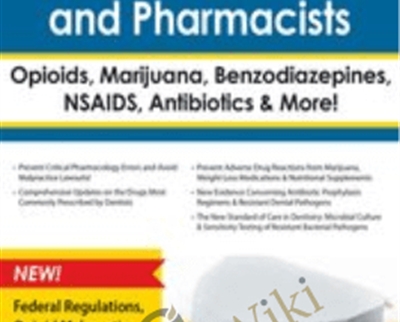Pharmacology Update for Dentists and Pharmacists: Opioids, Marijuana, Benzodiazepines, NSAIDS, Antibiotics and More – Eric Bornstein
 Do you have any idea what concurrent benzodiazepine, marijuana and/or SSRI use means to your medical and pharmacology decisions for these patients
Do you have any idea what concurrent benzodiazepine, marijuana and/or SSRI use means to your medical and pharmacology decisions for these patients
Pharmacology Update for Dentists and Pharmacists: Opioids, Marijuana, Benzodiazepines, NSAIDS, Antibiotics and More by Eric Bornstein,
Salepage link: At HERE. Archive:
Did you know that 1 in 5 of your adult patients is currently using Marijuana?
Are you aware that more than half of your patients have an SSRI prescription at home and the other half have either an opioid or benzodiazepine prescription at home before they ask you for medications?
Do you have any idea what concurrent benzodiazepine, marijuana and/or SSRI use means to your medical and pharmacology decisions for these patients, or how you can best protect yourself from a malpractice suit with these patients?
If you are unsure, then you can’t afford to miss this opportunity to join Dr. Eric Bornstein for this comprehensive pharmacology update. Dr. Bornstein will make sure you leave this live webcast confident in your knowledge of new prescribing rules, new contra-indications, evidence-based antibiotic therapy and more. And, we’ll include free customizable opioid informed, consent forms and updated drug history forms.
We guarantee you will leave this live webcast prepared to protect your patient and yourself!
- Determine the 20 most common drugs that your dental patient may be taking with interactions and contraindications, including marijuana, new anticoagulants, new weight loss pills and nutritional supplements.
- Evaluate clinically proven new and modern pain management principles and strategies mandated by the FDA and the CDC concerning opioids.
- Analyze the dentist and hygienists role in understanding new resistant dental pathogens and new antibiotic regimens in the era of multi-drug resistant infections.
- Assess new evidence concerning antibiotic prophylaxis regimens for your patients, and how this will affect you medical/legally.
- Point out malpractice issues with prescribing opioids, antibiotics, and combinations of meds.
- Integrate updated Customizable Opioid Informed Consent Forms and new updated Drug History Forms into your practice to satisfy government mandates and prevent malpractice claims.
- Specify new anticoagulants, weight loss medications and nutritional supplements that your patients may be taking.
Drug/Drug Interactions To Look Out For With Existing Patient Medications
- Opioids
- NSAIDS
- Benzodiazepines
- Marijuana
- Herbal Supplements
- Antibiotics
- BP Medications
- Blood Thinners
- Cholesterol Medications
- Thyroid Medications
- Anti-Diabetic Medications
- SSRI’s
- Weight Loss Medications
- Immunosuppression Medications
New Multimodal Clinical Pain Management Strategies:
- Advanced Evidence-Based Pain Management Principles to Lessen the Need for Opioids
- Pharmacology, Adverse Reactions, & Contraindications of OTC Analgesics & Opioids
- Aspirin, Ibuprofen, and Naproxen – (Non-NSAID Acetaminophen)
What Are Opioids
- Opioid Analgesics/Opioid Receptors/Opioid Metabolism
- Indications, Dosage, Precautions, Pharmacologic Effects & Adverse Reactions for:
- Codeine/Acetaminophen
- Hydrocodone
- Oxycodone
- Tramadol
- History of the Opioid Epidemic – it is NOT what you think…
- The NEW Benzodiazepine Epidemic
What Is New In The Last Five Years?
- Opioids and the ADA, FDA, CDC & Media
- New Malpractice Implications of Dental Opioid Prescriptions, FEAR the Lawyers!
- Signs and Symptoms of Opioid Disorder – Opioid Abuse, Addiction & Antagonists
- The Potential New Criminal Implications of Dental Opioid Prescriptions, Its Real!
There Is A New Standard Of Care For Dental Infections
- Microbial Culture & Sensitivity Testing of Difficult Infections
- How to Bill with Dental Codes and Where to Send Culture Samples